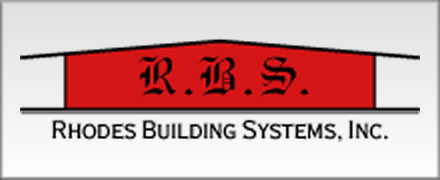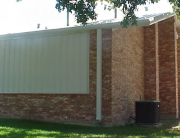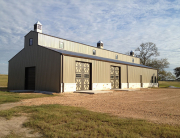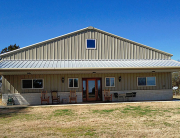Sitework consist of everything that it takes to stabilizing the ground against movement, make the site level & drain properly. In this installment we will use the Tarlton Supply facility located in Brenham, Texas as our example.
- Broken Brick
- Building pad at finished elevation ready for concrete
- Site stripped of vegitation
- A large yellow bulldozer at a construction site low angle view
- Checking Elevations
- Compacting Soil
- Correcting Drainage Retention Pond
- Stabilized soil
- Stabilized soil
Stabilizing the Ground Against Movement:
Soils with a clay base for example tend to have more movement than say a solid rock. Clay based soils typically have a high PI or Placidity Index. This index expresses the movement of the soil through moisture change. The higher the number on the index the more the soil will move.
At Tarlton Supply we once had a site at that location where the soil test showed a movement of +6” from wet to dry soil conditions. In extreme cases like this one the engineer had us excavate the site & import new stabilized fill material. As the soil was being imported we also compaction tested it to ensure proper soil compaction. In addition to the extra sitework the engineer also beefed up foundation design & added drilled piers to help reduce foundation settling.
Leveling Site:
Most building sites are unlevel. Meaning one area of the building’s site is too high while another point may be too low. In addition to being level the elevation of the site may have to be either raised or lowered.
In Tarlton Supply’s case the building was a tie-in. The new buildings finished floor height had to be raised to match the existing buildings. When setting the grade or elevation you need to keep in mind the door locations and their elevations. In this case the walk door and OH-Doors had to be strategically placed to comply with ADA accessibility standards.
Proper Drainage:
One of the major obstacles that we faced on this project was the drainage. The building location was relatively fixed and had little room for adjustment. It was also located in the center of three large buildings. All three existing buildings drained in the direction of the new building. The water was then diverted to a common point that drained to a lower parking lot. The ground had to be reshaped to push the storm water away from the building and into the common choke point.
Long Term:
Proper compaction of the appropriate fill materials will ensure the initial success of the foundation but moisture control should be the site’s long-term goal. Imagine a dry soil condition on one side of a building and saturated soil on the opposite side. Remember in this case study the soil moves +6” from wet to dry. A flower bed for example on one side of a building that gets over watered could cause that side of the foundation to heave up to +6”. While the un-watered side remains at 0” of movement. This is the very reason that many home builders started installing sprinkler systems in residential neighborhoods. The building with a sprinkler system tends to stay wet all the way around controlling moisture. Or you don’t water them and they dry out evenly. Look as you drive through a residential neighborhood at broken brick in the corner and you will very easily understand what I am referring to.
Summary:
All land is unique and has its own unique set of conditions. More unknown variables lie in the sitework than in any other area of construction. That’s why it is virtually impossible to budget sitework without seeing the site in person or having extensive civil drawings completed. This is one of the most overlooked areas of construction but it’s also the most important. Keep in mind foundation problems rarely begin with the actual foundation.














Leave A Comment